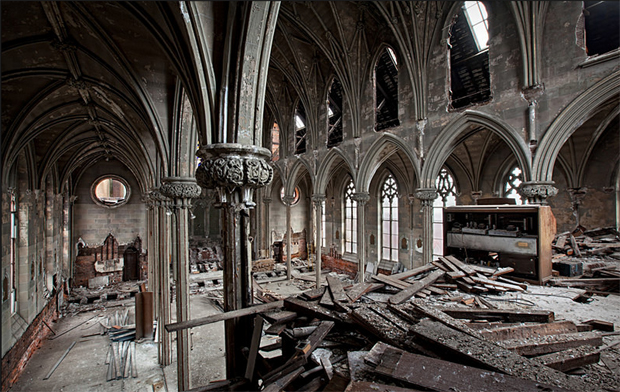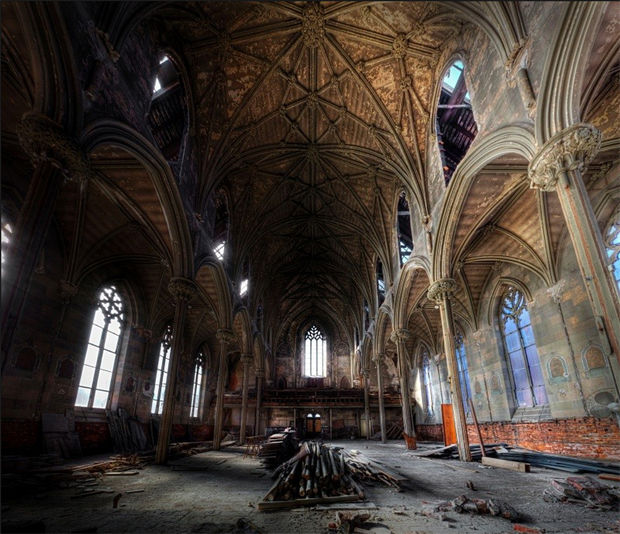Local photography teacher and lecturer Matthew Christopher specializes in recording for posterity abandoned buildings of all sorts – factories, power stations, hospitals, insane asylums, hotels and yes, churches.
It’s part vocation and part avocation. Some of his work was exhibited at Philadelphia’s American Catholic Historical Society on Oct. 29 and he will have a reception at St. Joseph’s University on Nov. 21.
(See Christopher’s work on his website here.)
[hotblock]
When great buildings outlast their original purpose, there are three options – repurpose them, tear them down or let them sit in slow decay until inevitably they must be demolished. It is this last category that most attracts Christopher.
“First, I would like to work toward a discussion for saving these buildings,” Christopher said. “They say it cannot be done and I say, ‘Why not?’ There are absolutely ways we can be reusing historically significant buildings and we are not looking at them.”
Secondly, he said, “If we are going to lose these buildings we should document them. A lot of people think of documentation as historical photographs. The period when the building is not being used is part of its history too, and part of the community history as well.”
Christopher was working in the mental health field when he first got the bug for photographing abandoned buildings. His first foray into the field was a night of exploring the buildings and tunnels of the huge complex of buildings and tunnels at Philadelphia State Hospital at Byberry, which have since been razed.
“Churches are the only buildings meant to be works of art with form taking precedence over function,” he said. “They are meant to inspire and speak of things that are greater than you.”
One thing that struck him at Byberry and other mental health facilities he has documented was the beauty of the buildings. “You can see they really cared about the patients when they were built,” he said.
Since then, he has documented the interiors of many abandoned factories, schools and resort hotels all over the country. One example is the Packard automobile complex in Detroit, which is reportedly the largest abandoned industrial site in North America. Another example is the federal government’s airplane graveyard in Arizona for thousands of obsolete aircraft.
But when it comes to the abandoned factories, Christopher believes the issue is tied to the outsourcing of labor to other countries with the use of child labor and unsafe working conditions.
“This is a huge discussion and the worst thing we can do is not have it,” he said.
Churches are a special category and present a special challenge, he believes. Local closed Catholic churches he visited were Transfiguration, Assumption, and Most Blessed Sacrament, all of which were beautiful and cultural treasures.
“Churches are the only buildings meant to be works of art with form taking precedence over function,” he said. “They are meant to inspire and speak of things that are greater than you. The loss of them is particularly painful.”
The problem of course is that churches, especially large churches, do not lend themselves to other uses. One rare exception, for example, is the St. Agatha complex at 38th and Spring Garden streets. Closed in 1960, it was resurrected as the Cloisters Apartments.
In any case, in Philadelphia many of the church closings are directly linked to the more utilitarian factory closings. First built were the factories which attracted workers who in the pre-automobile age tended to live near their workplace, which meant a church would be built for them. When the factories closed the people left and churches closed.
There are some reminders of the old factories that linger. For example, the huge Drueding factory in Kensington that processed leather and chamois cloth is long gone, but the private hospital that the philanthropic family built for its workers at 4th and Master streets survives as the Drueding Center – Project Rainbow, a shelter for homeless women with children.
Christopher would like to see more efforts made to save buildings that bespeak so much of the history of the community.
“These places are cultural treasures,” he said. “You can’t save them all but when you lose them you are stuck with Arby’s and Footlockers. They were built to stand the test of time and contributed to our country’s greatness.”
***
Matthew Christopher’s gallery presentation at St. Joseph’s University will take place in Thursday, Nov. 21 from 5 to 7 p.m. in the university’s Merion Hall. For more information on his work see his website, www.abandonedamerica.us
***
Lou Baldwin is a freelance writer in Philadelphia.
PREVIOUS: Archdiocese invites lay, clergy input on marriage and family life for Vatican meeting
NEXT: La Salle U plans to build $35 million building for business school





If I had a million bucks,I’d 1. Reconsecrate the Church to celebrate the Assumption, and the lives St.John Neumann and Katherine Drexel 2. Institute a cultural center, open to the public, celebrating the African American and native American cultures, including their lifestyles, art and literature 3. Invite creative contributions from The descendants of those helped by these saints 4. Enlist the help of these communities in restoring the church 5. Include an educational center to continue the work of these great saints, and apply for federal and state aid as a pilot project 6. Show the history of this church as part of Philadelphia’s heritage (apply for government aid for this depiction) 7. Model this project on the Basilica of the Sagrade Familia in Spain, which attracts millions of visitors of all faiths because of its beauty and creative art. The theme could be how these two saints followed their individual graces and how this Catholic and American value has reaped success and continues to bear fruit.
8. locate as many of the beautiful stained glass windows as possible.
These are a treasure in themselves and should be put back in place. 9. Hold as many ecumenical services as possible in this church and perhaps obtain permission for African American and native American separate services celebrating our religious diversity and tolerance.
Lou Baldwin’s journalism is a great service to all of us.
I love your proposal. Until the Assumption is leveled there is still a chance. Where there is a will there is a way. Certainly the full life of St. Francis inspired Pope Francis. But St. Francis’ dream where Christ says: “Francis, repair my Church which, as you can see, is falling into ruins.” is something that the pope has taken symbolically in his efforts to bring changes to the church. But a restored Assumption would give inspiration to the missionary efforts throughout the world and although it would be an expensive venture it could be a catalyst for fund raising well into the future. (It is my guess that many of the missing stained glass windows can be found in the recently built churches in the suburbs)